Download The Full Souvenir Section | Read The Full Text Piece
Chapter 1 The Evolution Of Mario Lemieux Read The Full Chapter
The friendly voice over the speaker says to come in, and the black iron gate rises and retreats. Inside, behind the towering green shrubs and ivy-covered brick walls that fortify his home, Mario Lemieux is waiting on the veranda.
Climbing the steps, there is so much to take in. Water springs from a sun-drenched fountain. His 11-year-old chocolate lab, Tara, ambles around. Lemieux reaches out his big right mitt for a handshake. In just a few seconds, it is very clear that, in building this immaculate terrace that overlooks a sprawling backyard complete with a small pool and a putting green, he has missed no detail.
Lemieux is prepared, having placed two small bottles of water on an end table that sits between a small sofa and a deck chair. The veranda’s red brick facade provides shade on a serene morning. He does not have to do any of this. He does not like to talk about himself, so why is he? Maybe it’s just time. He is not a nostalgic guy, though. Up in the attic, a box of mementos from his early days in Pittsburgh gathers dust. It was given to him by a family friend after his battle with Hodgkin’s disease, and it contains some of the mail he received during those trying days. He has never opened it.
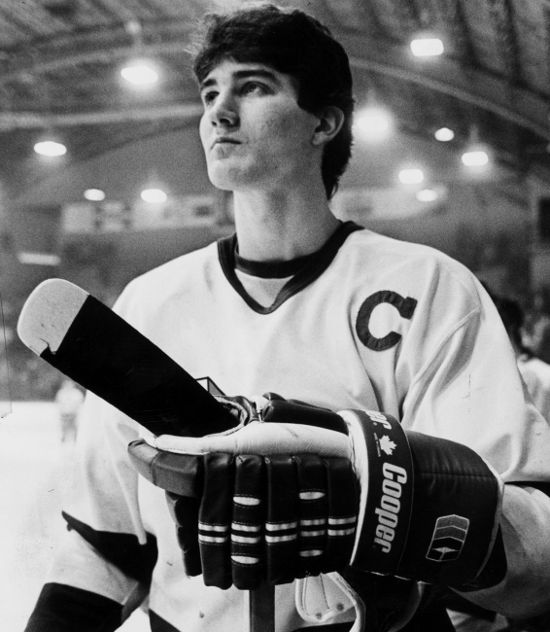
Special to the Post-Gazette from Le Soleil of Quebec
“I don’t sit here and just think about what I did in the past,” he says.
He is constantly evolving, has been since he rode in a black sedan with his father and agent through the Fort Pitt Tunnel and first laid eyes on the impressive skyline of a then-distressed city with a laughable hockey franchise.
With this fall marking his and Pittsburgh’s 30th anniversary together, Lemieux knows there are questions, and he has agreed to answer them. He will be honest but understated, open yet wary of going too far, many of his responses ending short of revelation and often with a quick smile, as if to say, “Trust me, that’s really all I’ve got.” English is his go-to language now, the French left for talks with his wife Nathalie or close friend Pierre LaRouche in the owner’s suite at Consol Energy Center.
The years have flown by, he says, and the last two decades have been here, attempting to blend in among some of Pittsburgh’s most affluent citizens in this leafy western suburb. This is a man who approved every nut and bolt of the first home he built, in Mt. Lebanon, made sure it was constructed to his specifications, and left it five years later because he wanted more privacy. He found it in Sewickley, but he still couldn’t escape his own mind.
Coffey asked Gretzky if he thought Lemieux could do it at the next level..."Oh, yeah."
Golf with his buddies is a cherished release, but mostly, the brain never stops, to the point that, since starting his career in Pittsburgh, he has struggled to sleep more than a few hours at a time. What does Lemieux think about? Even his closest friends can only guess. He insists it isn’t anything that deep; he has always been consumed by the ever-present tomorrow.
“I can’t figure it out,” he says. “When I played, at times I would pop an Ambien here or there. It’s been more and more the last few years, too, just thinking about a lot of stuff.”
Like what? The answer is a study in Lemieux.
“Just stuff that needs to be done,” he says. “You know, a couple houses here and there, paying the bills, just normal stuff that people go through.”
The Evolution of Mario Lemieux | Video by Steve Mellon; 11/27/2014
Lemieux’s lifelong search for normalcy began the moment he became a teenage star in Montreal. Where could he be the best hockey player in the world — Lemieux, after all, means “the best” — but not have to be treated like it every day?
Pierrette Lemieux somehow knew that life wasn’t going to stay simple for her boy. At 12, Mario was so dominant that top NHL executives were hearing his name. Bob Perno, Lemieux's first agent, heard about Mario from Scotty Bowman, then the coach of the Montreal Canadiens and one of the greatest hockey generals of all time. To sign Mario, Perno promised the family that his first contract in the NHL would be for a total of at least $1 million — an unheard of amount for a draft pick in those days.
“His parents looked at me like I had five heads,” Perno says.
At that age, Mario did not say much, but he wasn’t bashful about what he had in store for the game of hockey. He had always worn the number ‘27’ because that’s what Alain wore, but when deciding what number he should wear after he was drafted by the Laval Voisins of the Quebec Major Junior Hockey League, he first suggested Wayne Gretzky’s ‘99’ to Perno. Fixing Mario’s target straight at hockey’s “Great One” was too bold, Perno knew, so he suggested a more subtle route: How about ‘66,’ turning Gretzky’s number upside down?
“I want you to become as good if not better than Wayne,” Perno remembers saying. “I think you’ve got the potential to do that. Every time you look at that sweater, you will know who you have to measure yourself with.”
The Mario mystique was real. He knew that when he glanced up into the press box at the small Laval arena and saw Wayne Gretzky and his fellow Edmonton Oilers star Paul Coffey looking down on him. Mario’s pursuit of Guy LaFleur’s major junior records was generating quite the buzz, and Gretzky, who was in town to play the Canadiens, thought he had better check out the kid, at Perno’s urging (Gretzky was also a client of Perno’s boss, Gus Badali). After the game, in which Mario had humbled another opponent, Gretzky and Coffey went to introduce themselves in the locker room.
“A quiet kid with a curious smile,” Coffey says.
During the ride back to Montreal, Coffey asked Gretzky if he thought Lemieux could do it at the next level.
“You’re sitting there talking to the ‘Great One,’ you might as well hear it from him,” Coffey says. “Wayne had a twinkle in his eye, and he said, ‘Oh, yeah.’”

Marlene Karas / Pittsburgh Press
Chapter 2 Life In A New City Read The Full Chapter
Lemieux would be making his first friends and connections in a new country while facing tough lifestyle decisions for a teenager with a ton of cash. Penguins General Manger Eddie Johnston was not about to have Lemieux, who hardly spoke English, living in some downtown apartment where anybody could get to him. The first thing he needed was a good family to nurture him, give him a real sense of home.
Tom Mathews and his wife, Nancy, were Johnston’s choice. Tom was a prominent businessman in Bridgeville, working in construction, and their house in Mt. Lebanon was more than suitable for Lemieux, who had practically been raised in a box in Ville Emard. Johnston would drop hints to Tom. You wouldn’t believe this guy up there in Montreal... But he wouldn’t go further, leaving Tom to wonder. One day early in the season, Johnston invited Tom to practice and finally made his move.
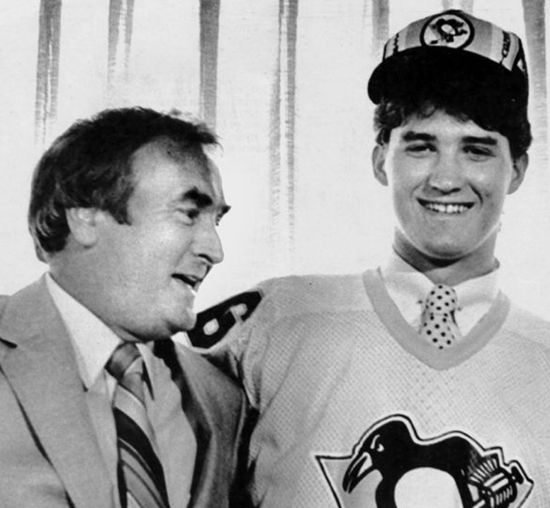
Lemieux after being drafted in 1984.
After practice, Lemieux and Johnston visited the Mathews’ big white house in the exclusive Virginia Manor neighborhood. Lemieux would have some privacy, with a third floor bedroom that had been used by the Mathews’ oldest son. It even had a water bed.
Nancy’s youngest son had just left the house, and she could already tell that an empty nest was not going to be her thing. In short, Tom’s reservations weren’t going to matter. The Mathews had Mario, Johnston and his wife Diane over for Sunday brunch to cement the deal.
“Why don’t you go get your clothes?” Nancy offered.
“I already have them with me,” Mario said.
At home with Tom and Nancy, Mario eagerly worked on his English. He found himself extremely self-conscious when he had to do interviews.
"Hockey is everything in Montreal. It's tough for players to go anywhere without being recognized."
“Because I would make a lot of mistakes,” he says. “Nancy was a good English teacher. I used to watch a lot of TV. If she was there, if I didn’t understand a phrase or word, she would try to explain it.”
Above all, they were fine as long as Mario could explain to Nancy what he wanted to eat. One time, she was trying to gauge if he liked lamb, and Mario responded, “Is that fish?” Once they had reached an understanding, she’d cook it up for him.
After a month, Mario’s two worlds met when his parents visited Pittsburgh. They did not speak English, and the Mathews did not speak French. Mario did his best to handle the role of translator with the help of agent Bob Perno.
“Mario was very shy, really very quiet, stayed to himself a lot,” Nancy says. “But after his parents came, we all sat around and talked with one another, and I think after that point, he felt more safe. If he had a question, he would come and ask me.”
Lemieux scores his first NHL goal
Mostly, having Mario around wasn’t much different for the Mathews than it had been with their three sons. But, one day, a truck pulled up in front of their house carrying a white Ferrari. Neighbors assumed that Tom Mathews was going through a mid-life crisis, but nope, that was just their Mario, stepping out a bit.
“He was too tall,” Tom Mathews says, “so we had to take it to a custom place to give him more leg room.”
Riding in style, Lemieux would win the Calder Trophy as rookie of the year. After, he would spend the summer in Montreal, the trip affirming that it was no longer a place he could live.
“Hockey is everything in Montreal,” Lemieux says. “It’s tough for players to go anywhere without being recognized.”
With Mario heading toward his first 100-point season, Tom knew that Mario would be due for a bump in pay. It just so happened that big-time baseball agent Tom Reich lived on a parallel street and shared a backyard with the Mathews. Lemieux met Reich at Tom’s urging, and Reich, who was known as a fierce negotiator, worked his way into Mario’s graces with his boisterous personality.
Lemieux may have increased his firepower with Reich, but it ended up being the player himself who took the lead in negotiations with the Penguins.
One day, Lemieux and Reich drove to Steubenville, Ohio, where the DeBartolos, who owned the team, operated their business, intent on forcing their hand. Lemieux demanded that they draw up a new contract right then and there and threatened to leave the team and return to Montreal if they didn’t.
Lemieux knew they would have no choice. Attendance was up, and the Penguins were starting to make a dent in the market. By that point, he was the franchise.
“It wasn’t a class organization until he got there,” says Tony Liberati, who worked for the DeBartolos and was in the room when Lemieux made his ultimatum.
The DeBartolos extended Lemieux that day, agreeing to a contract that would put him over the $2 million per year threshold, joining only Wayne Gretzky.
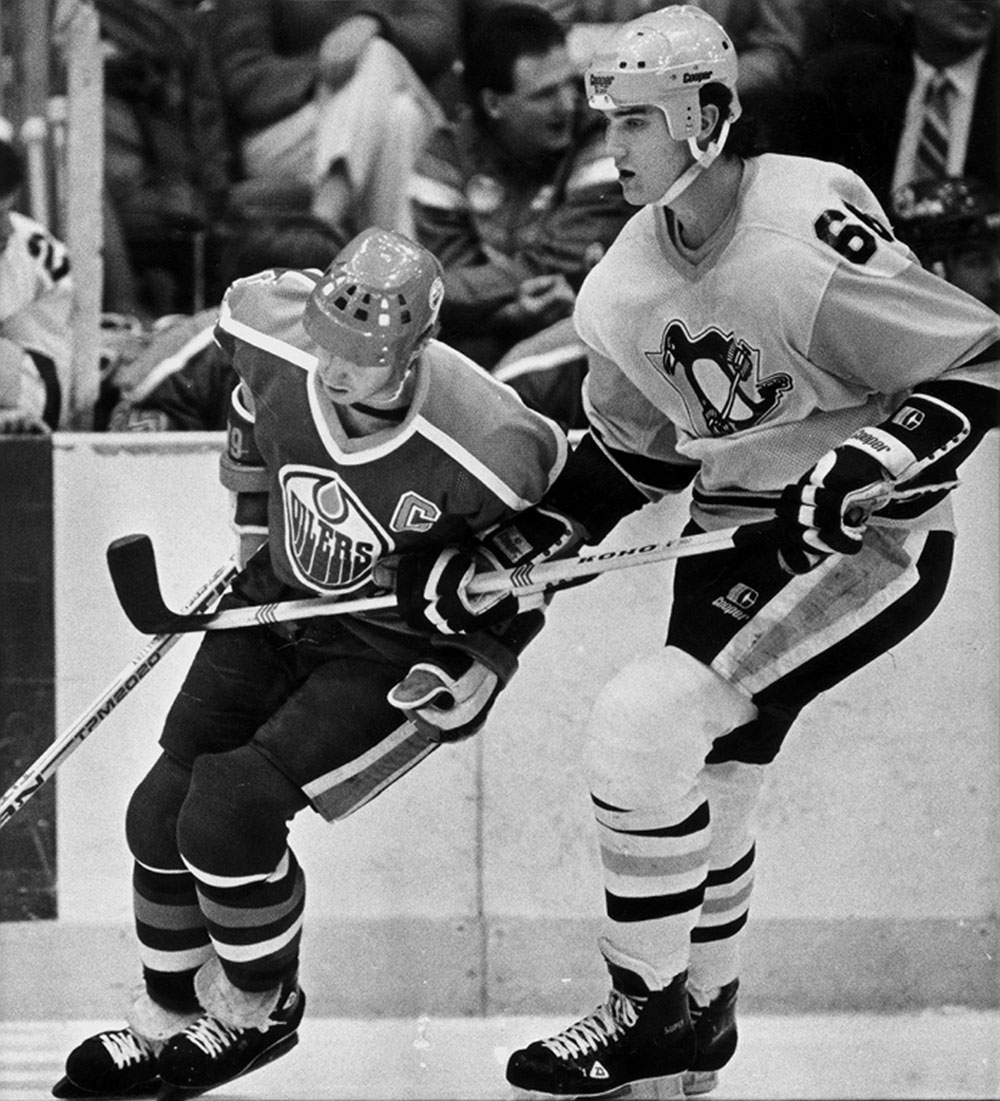
Post-Gazette archives
Chapter 3 The Rise Of 66 Read The Full Chapter
Mario Lemieux spent his first three years in the NHL in the shadow of a legend.
Wayne Gretzky’s numbers said it all after the 1987 season: Eight straight Hart Memorial Trophies as the NHL’s most valuable player. Seven straight Art Ross Trophies as the league’s leading point scorer. Winner of three of the last four Stanley Cups.
“I had the mindset of becoming the best in the world,” Lemieux recalls. “Looking at Gretzky, the way he was racking up points, I had a long way to go.”
So when Lemieux arrived at training camp for the 1987 Canada Cup late that summer, he relished the chance that was in front of him. He would be skating against the best players in the world, surrounded by the firepower of Team Canada, including the “Great One” himself.
“Mario was always a study,” says Paul Coffey, another Canada Cup teammate. “Mario watched every move Gretz made. There were no insecurities, and Wayne wanted to teach him.”
"That was the turnaround in my career...learning what it took to be a champion."
Four years after passing on a chance to play for his country in World Juniors, Lemieux dazzled on his home soil, scoring seven goals in the first six games and helping the Canadians advance to the three-game championship series against the Soviet Union, which would bring its incomparable allure to the event. Back in Pittsburgh, Penguins diehards gathered around their televisions to see if Lemieux could show the world what they already knew: Mario was unstoppable.
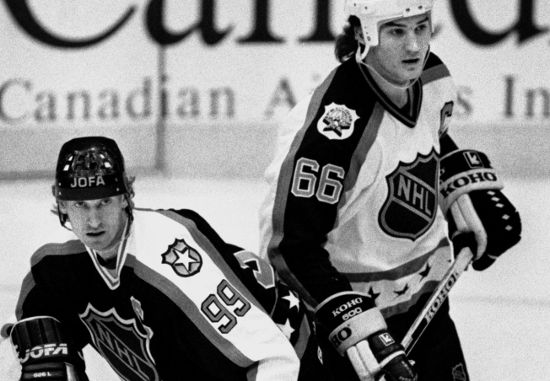
Lemieux and Gretzky in an NHL All-Star Game
For the tournament, Lemieux scored 11 goals — the closest competitor had seven — and Gretzky took MVP honors with 21 points. Lemieux then headed for Penguins training camp, where he arrived a different person.
“That was the turnaround in my career,” Lemieux says. “It was six weeks of playing with the best in the world, learning what it took to be a champion. "I looked up to Gretzky. He was the hardest worker in practice, even though he was the most talented. His work ethic was incredible.”
Lemieux’s teammates immediately took notice. In past years, he had shown up to camp and dominated simply because he was Mario Lemieux. Phil Bourque recalled one time asking him where he’d been all summer, because Bourque hadn’t seen him. “This is the first day I put my skates on,” Lemieux had said.
“It was night and day to me,” Bourque says. “He was a man. It was a body language thing. When he looked at you, and you looked at him, you knew … he’s going to another level right now, and you better get on board.”
Lemieux would follow the Canada Cup with his breakout season in 1987-88, unseating Gretzky for the first time as the Hart and Ross winner with 168 points (70 goals). The next year, he would tally 199 points to bring home another Ross.
The gradual polishing of Lemieux was becoming apparent off the ice, too. Howard Baldwin, the Penguins’ new owner, was part of the Los Angeles social scene as a Hollywood producer and sensed his newly acquired talent in Pittsburgh — had he wanted to live life in the spotlight — would have fit right in.
Baldwin was in awe of Lemieux. After the Penguins’ second Stanley Cup in 1992, when Lemieux and agent Tom Reich approached Baldwin about a major contract extension that would make him the highest-paid player in the NHL and keep him in Pittsburgh until the end of the decade, Baldwin didn’t balk, agreeing to a seven-year deal worth $42 million plus bonuses.
And to show how just how far Lemieux had come, Reich had included some specialized language in the contract: Lemieux would always be paid at least $1 million more per season than Wayne Gretzky.

John Beale / Post-Gazette
Chapter 4 Crises Create Deeper Bond Read The Full Chapter
Dr. Charles Burke, the team's physician, stressed to Mario that they had caught it early, Stage 1. That Hodgkin’s lymphoma, a cancer of the lymph nodes, had a survivor rate of 90 percent. Those assurances helped, but here was a 27-year-old man contemplating his mortality for the first time.
Lemieux drove back to Sewickley with the news eating away at him. Nathalie waited at home, planning Lauren’s birth and a fancy Montreal wedding at historic Notre Dame Basilica. Lemieux pulled over to the side of the road and cried, a scene he softly described at an emotional press conference days later in Pittsburgh. Whether he wanted to or not, he had let people in, and, all over the city, those who knew him and those who didn’t joined in praying for his quick recovery.
“People sent him family medals, bottles of holy water, Rosary beads,” says Nancy Mathews, Mario’s Pittsburgh mother. “He touched a lot of people, even more than he realized.”
TimelineMario Lemieux [+] Click To View The Timeline
At home, Nathalie showed impressive strength. “Don’t cry for him, don’t show any weakness. He’s going to be OK,” she told Nancy when the Mathews first visited.
Lemieux had spent so many nights over the years awake, thinking about what lay ahead and what he was going to do about it. With weeks of radiation therapy staring him down, that wasn’t easy to do. So, he just thought about hockey. “I had a big lead on Pat Lafontaine,” Lemieux says of the points race. “I would stay up at night and watch ESPN and find out how many points he got, day after day. He got a lead, and that was my goal, to come back after the last treatment and step on the ice and start chasing him. That was important for me. That was a challenge.”
the Philadelphia fans who had lustily booed him for years were now on their feet, cheering him
On the morning of March 2, 1993, Lemieux had his last radiation treatment. He had missed 23 games, and Lafontaine now led him by 12 points with 20 games to go. The Penguins were playing that night at Philadelphia against the hated Flyers, and Lemieux wasn’t going to miss it. He hopped a plane and arrived at the Spectrum, surprising everyone, even NHL commissioner Gary Bettman, who didn’t have time to get to Philly from New York to witness it.
When Lemieux took the ice, the Philadelphia fans who had lustily booed him for years were now on their feet, cheering him. Having not skated for nearly two months, his body tired from blasts of radiation, Lemieux scored a goal and an assist in a 5-4 Penguins defeat. That felt remarkable, but he was just getting started.
Pittsburgh ran off an NHL-record 17 straight wins, as Lemieux set his sights on Lafontaine. Playing some of the most inspired hockey anyone had ever seen — never mind the circumstances — he scored 30 goals and 26 assists after his return to pass Lafontaine and win by 12 points.
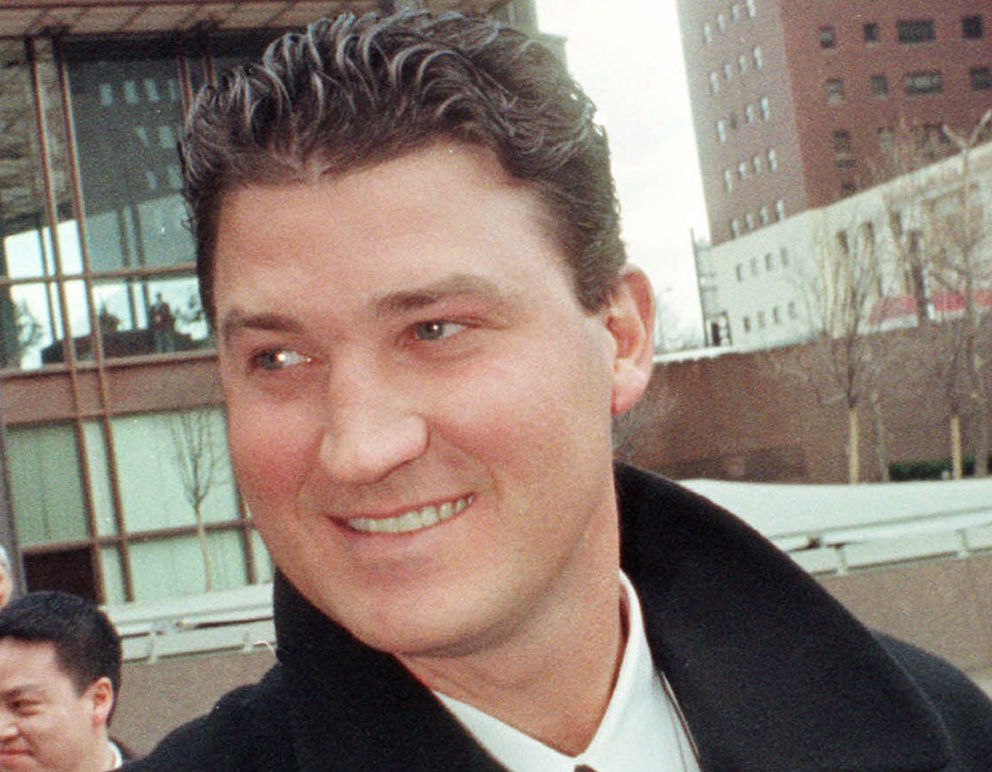
Keith Srakoci / Associated Press
Chapter 5 A Fortune At Stake Read The Full Chapter
The Penguins owed Lemieux around $32.5 million, even as he did not play out the length of his contract. But Roger Marino, who had joined Howard Baldwin’s ownership group and kept it afloat, had decided that paying Lemieux was not part of his plans. Lemieux had already sued Marino, but now that Marino had taken the team into bankruptcy, the situation was even more serious. Depending on how it went in the courts, Lemieux, an unsecured creditor, could get next to nothing.
When Lemieux decided that 1996-97 would be his last season, his contract was still guaranteed. Reich had gotten doctors’ notes for Baldwin that said the long-term health of Lemieux’s back was in jeopardy. If it had been a leg injury, for instance, Baldwin could have had grounds to not pay Lemieux for the remaining years. Because it was the back, and Reich had included stipulations about this exact scenario in the contract, there was nothing Baldwin could do about it. Mario was a rich man who was about to get richer.
“I thought everything was secured,” Lemieux says.
So how does a franchise that recently won two Stanley Cups go bankrupt? Howard Baldwin had bought the team from the DeBartolos without investing much capital, striking a deal with arena management company SMG that allowed it to take on the running of the events and pocket the profit as long as the Penguins could remain at the Civic Arena. At that time, though, player contracts (like Lemieux’s) were about to skyrocket, and arena revenues, with the inclusion of luxury boxes and corporate suites, were about to explode. Baldwin’s stake was in the side of the operation with growing expenses, not the one with increasing revenues. His business model was flawed from the start, and he didn’t have the resources to reverse the tide.
That night at Morton’s, it was time to discuss the options. Lemieux just listened, which was his way. Tom Reich started talking, which was his way. Reich said that the only way to guarantee Lemieux would get his money — and that the Penguins would remain in Pittsburgh with proper ownership — was for Lemieux to put together a group to buy the team out of bankruptcy. It was wild, insane even. But Lemieux considered it. They proposed the scenario to bankruptcy attorney Doug Campbell, who had the legal know-how.
“I said, ‘OK, do you have any money?’ No. ‘Do you have any investors lined up?’ No,” Campbell says. “OK, so you’re telling me a $30 million unsecured creditor who has no investors lined up is going to go head to head against two publicly-traded corporations, one of which has the master lease for the Civic Arena and the other the TV rights, and we don’t even have a telephone or an office, and we’re going to outmaneuver them legally and financially and get control of the franchise?”
Well, yes.
“I just thought, that’s something that’s never been done before,” Campbell said, “especially in the context of a sports franchise, to have an unsecured creditor try to take control of a case where he had so little leverage. The only thing we had going for us is the goodwill that comes with Mario Lemieux’s name. Otherwise, it was a little bit like if someone said to you, ‘I’d like to build a bridge across the Grand Canyon, but I don’t really have any financing lined up, and you have to get it done within the next 12 months.”
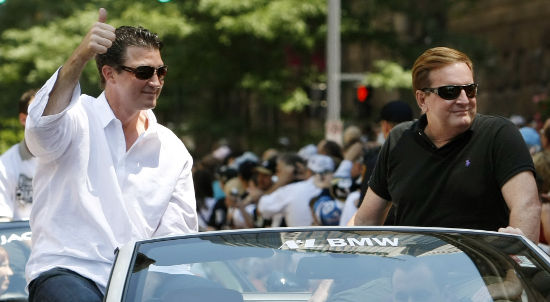
Lemieux and Ron Burkle
They still needed to reel in a big fish to invest with Lemieux. Once they had that, they could easily fill in the rest. Tony Liberati, who was a minority part of Team Lemieux’s ownership group, reached out to Ron Burkle, a Southern California venture capitalist who made hundreds of millions of dollars in the grocery business. Liberati and Burkle had a prior relationship from when Burkle bought Ralph’s grocery company from the DeBartolos.
Lemieux had his guy. Burkle would go in as an equal partner with Lemieux.
Liberati asked Burkle, who was scheduled to fly from London to the U.S., to make a stop at the airport in Palm Beach, Fla. He agreed, and Lemieux and his team met him there. For about 20 minutes, Lemieux and Burkle spoke to each other alone, as Lemieux sold the billionaire on himself, the Penguins and Pittsburgh as a worthy investment.
Lemieux had his guy. Burkle would go in as an equal partner with Lemieux. When they delivered the news to Bettman in New York, the commissioner’s eyes got big. Lemieux had now legitimized himself.
With the judge’s backing, Team Lemieux brokered a deal with SMG that would transfer the arena lease back to the team after a few years. FOX had already joined Lemieux’s side. By spring 1999, the pieces had come together, and after a tense summer of final negotiations, the court approved Lemieux’s purchase of the team on Sept. 3.
But there was no Stanley Cup-style celebration at Lemieux manor. There was too much to be done. On Lemieux’s orders, the 29 creditors were to all be paid 100 cents on the dollar — a rare feat in bankruptcy cases — and it wouldn’t be long before the new owners would have to start the colossal endeavor of getting a new arena built. Civic Arena was ready to fall on top of them, and the franchise wouldn’t be safe until it had a new home.
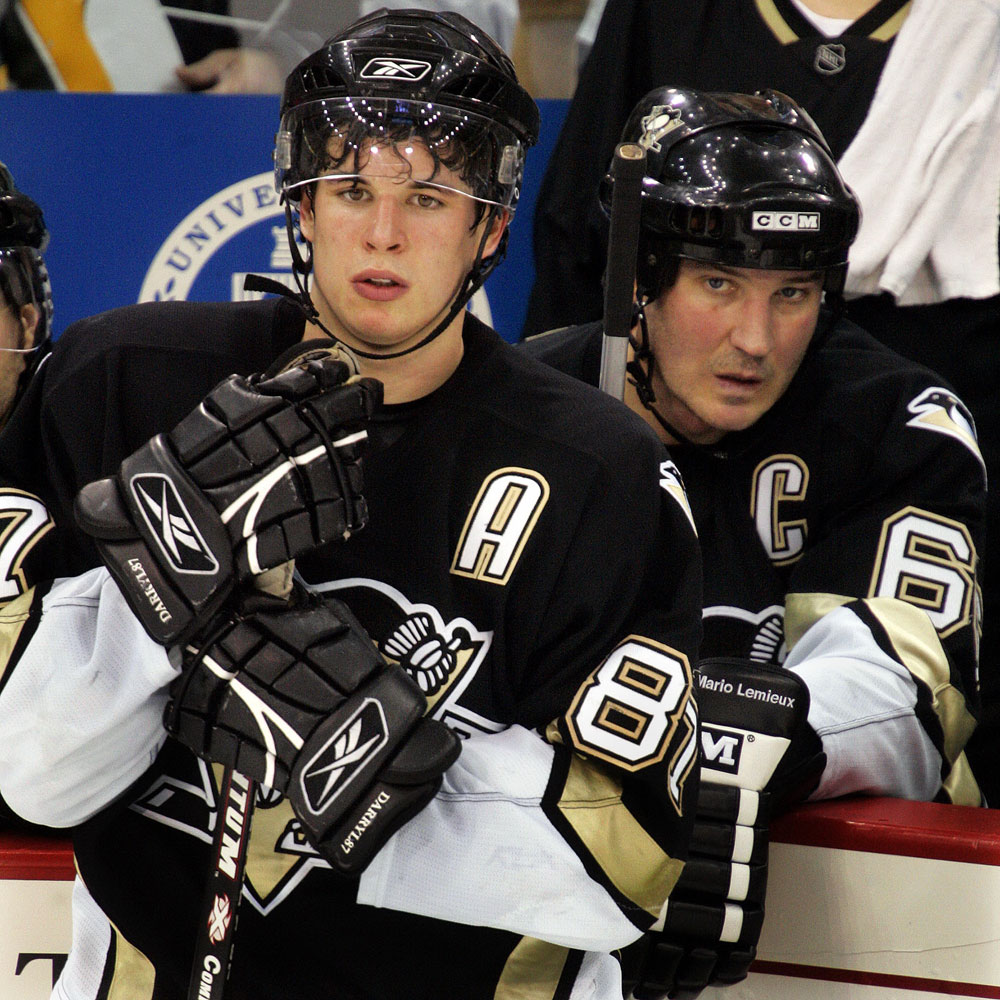
Gene J. Puskar / Associated Press
Chapter 6 The Double Life Of 66 Read The Full Chapter
When Jay Caufield picked up his phone in fall 2000 and heard Lemieux’s voice on the other end, he figured it was just his friend setting up another tee time. Turned out, it was anything but.
“Hey,” Caufield recalls Lemieux saying, “what are you doing the next couple weeks?”

Lemieux wanted Caufield to start working him out, and Caufield did not push for more information. With Lemieux, it was always better not to pry.
Once they hit the ice, Lemieux did not have to say that he was thinking of making a comeback. Caufield could see it in his frustration at all the things he was unable to do. Lemieux had talked to his friend Michael Jordan about the challenges that he would face in coming back after an extended layoff, as Jordan had done, but experiencing them for himself was another thing entirely.
“The toughest part that we found in our comebacks,” Lemieux says, “was your body adjusting to the training that it needs to be a world-class athlete.”
Caufield could see it in his frustration at all the things he was unable to do.
Soon, Lemieux would pick a date — Dec. 27, 2000, against the Toronto Maple Leafs at the newly-named Mellon Arena — and announce his comeback to the world. He would remain the team’s owner, and certainly his return would put more people in the seats, helping the bottom line.
“But that’s not who Mario is,” Greenberg says. “That would have been a mercenary decision.”
Lemieux looked at players like Jaromir Jagr and Alexei Kovalev, and he thought there was a window for another Stanley Cup run. He also wanted his children, especially 4-year-old Austin, to be able to see him play and remember what it was like. Plus, “I missed the game,” he says.
Caufield had brought Lemieux back just as he’d planned. In 43 regular season games, he scored 76 points (35 goals and 41 assists), finishing second in the MVP voting. The Penguins advanced to the Eastern Conference Finals, losing in five games to New Jersey.
It had been a magical season for Lemieux, the Penguins and Pittsburgh. But through it all, Lemieux was still having to switch hats. A brutal reality had set in that the franchise had to consider trading Jagr — who won the scoring title that year and had played all 11 seasons of his career in Pittsburgh — to save money. Jagr was owed $20.7 million the next two seasons, and he had been asking for a trade for months. So Lemieux and the cash-strapped Penguins gave Jagr his wish, dealing him to the Capitals for three players who would never impact the Penguins.
Two seasons later, in February 2003, the Penguins would trade Kovalev to the Rangers for $4 million cash and more throwaway players.
These were not the kind of moves a competitor like Lemieux would have ever wanted to make, but, living in a post-bankruptcy world with an NHL lockout looming, he had to do what was best for the franchise’s long-term stability.
While the lockout of 2004-05 was disastrous for hockey as a whole, it would end up being a blessing for the Penguins. To stay afloat, small-market teams especially needed a salary cap. The players, after 10 months of bitter negotiations, agreed to one July 21, 2005.
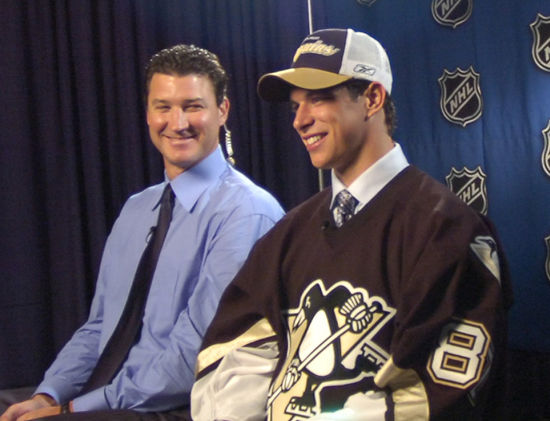
Lemieux and Sidney Crosby after the NHL Draft.
"We got him! We got Sidney!"..."I don’t remember ever hearing him that excited."
A day later, the NHL, in a hurry to get things moving, held a draft lottery. It was the Sidney Crosby Sweepstakes. Even more so than Lemieux, who had to play in the shadow of Wayne Gretzky, Crosby, a Cole Harbour, Nova Scotia native, had been anointed by Canadians as the next coming of the “Great One.” Some team and some city were about to get very lucky.
The Penguins, because of their recent on-ice woes, were one of four teams with the best chance (6.25 percent) to get Crosby. Sure enough, the last two ping pong balls remaining were the Penguins and Ducks (who started at 4.17 percent). After having Lemieux drop into their laps two decades ago and winning two Stanley Cups, it was hard for anybody outside of Pittsburgh to root for the Penguins. But Mario Lemieux knew just how much his franchise needed anything positive to happen.
The Ducks were the second-to-last ball taken. Crosby was headed to Pittsburgh.
“Mario called me and said, ‘We got him! We got Sidney!’ ” Grealish says. “I don’t remember ever hearing him that excited.”
The 2005-06 season had the potential to be a hockey fan’s dream. Here was the 40-year-old Lemieux handing off the baton to the 18-year-old Crosby each night for the world to see.
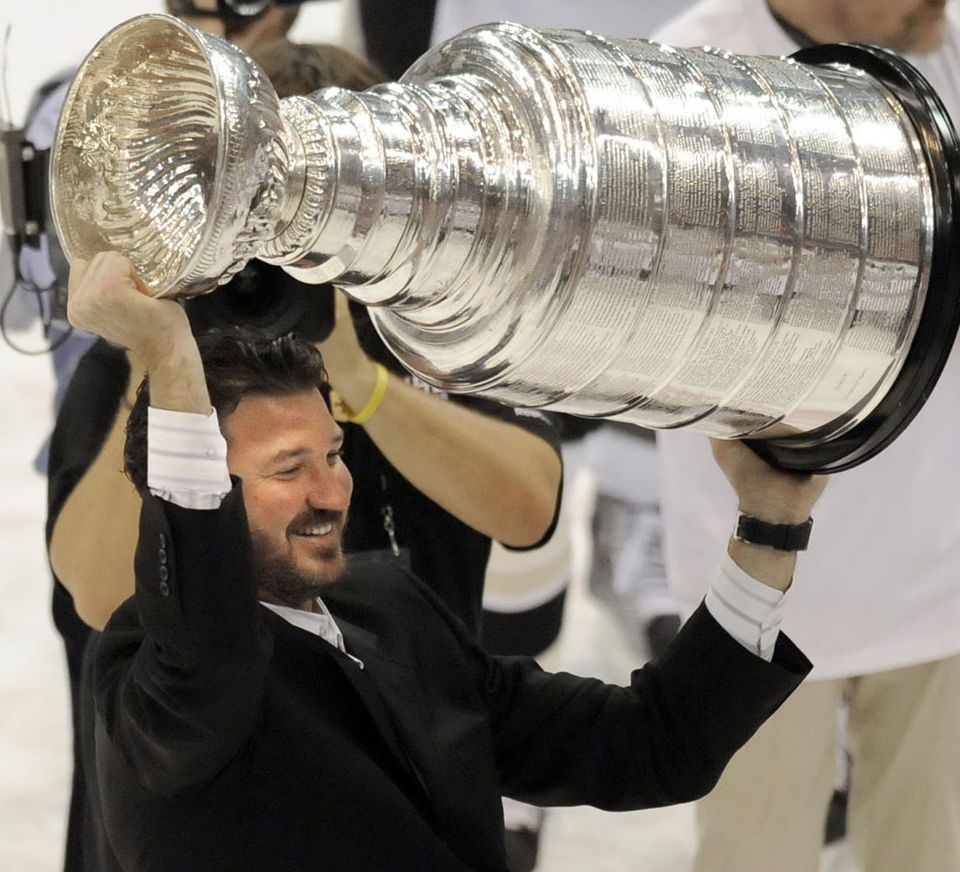
Matt Freed / Post-Gazette
Chapter 7 A Test Of Loyalty Read The Full Chapter
“It would have been easy for us to pack up and move to Kansas City,” Lemieux says. “Everything was taken care of. But at the end of the day, I wanted to give Pittsburgh one last shot to make a deal with us before we decide to make the move.”
The Penguins finally had created enough leverage to move Rendell. The governor agreed to not make the Penguins pay anything up front, and they would only have to contribute $2.2 million annually. On March 13, 2007, the sides announced that the Penguins would remain in Pittsburgh for the next 30 years with a new arena in Uptown. The franchise — and Lemieux’s legacy as its savior — would live on.
"Your Pittsburgh Penguins will remain right here in Pittsburgh where they belong!"
That night, the Penguins were playing the Sabres at Mellon Arena, and the team’s vice president of communications, Tom McMillan, asked Lemieux to go onto the ice and trumpet the victory. Lemieux said no. He was not one for victory laps. But McMillan called Grealish and asked him to plead with his friend.
“I’m not going out on the ice tonight,” Grealish recalls Lemieux saying.
“You are going out on the ice tonight,” Grealish told him. “You’ve got to go out and say something. This isn’t about you. It’s about them.”
Lemieux suddenly understood. The fans, who had cheered him for more than two decades, needed to hear from him in that moment. Before the game, he went onto the ice and took the microphone.
“Your Pittsburgh Penguins,” he said, “will remain right here in Pittsburgh where they belong!”
Lemieux pours melted ice from Civic Area onto the center ice of Consol Energy Center
Those words, from this man in front of these people, signified a completed journey. What had the last 23 years been other than Mario Lemieux slowly finding his voice and then realizing what he could do with it, if used at just the right time? It had been that way as a captain, as the face of a foundation, as the owner who surprised everyone by stepping forward. Through it all, he was an observer first, a decision-maker second, and he had somehow managed to get what he needed for himself and his family while at the same time doing what was right for Pittsburgh.
Now, the fun could start. This was supposed to be fun, remember? Hockey had always been the easy part, and from the owner’s box, Lemieux could see it coming together. Crosby was a dynamo, Marc-Andre Fleury was developing in net, and they had gotten Evgeni Malkin over to Pittsburgh from Russia through some Cold War tactics.
As an owner, Lemieux was now solely focused on the business and helping to create the right hockey culture. He stayed in the background publicly, but he would visit the locker room after each game to show his support for the guys, and when the Penguins would bring in a new player, he would always personally greet him. Somewhere along the way, he had figured out what a handshake and a smile meant to others.
“It was very satisfying,” Lemieux says. “It’s certainly not the same as when you’re a player and you win the Cup for the first time. It was a great process. Obviously getting the lottery changed the whole franchise, to be able to get Sid and build around him, knowing that year after year we were going to have a pretty good chance to be successful.”
They were champions again, and after one final season at Mellon Arena, they would have a new home at Consol Energy Center, where they’d make fresh memories.
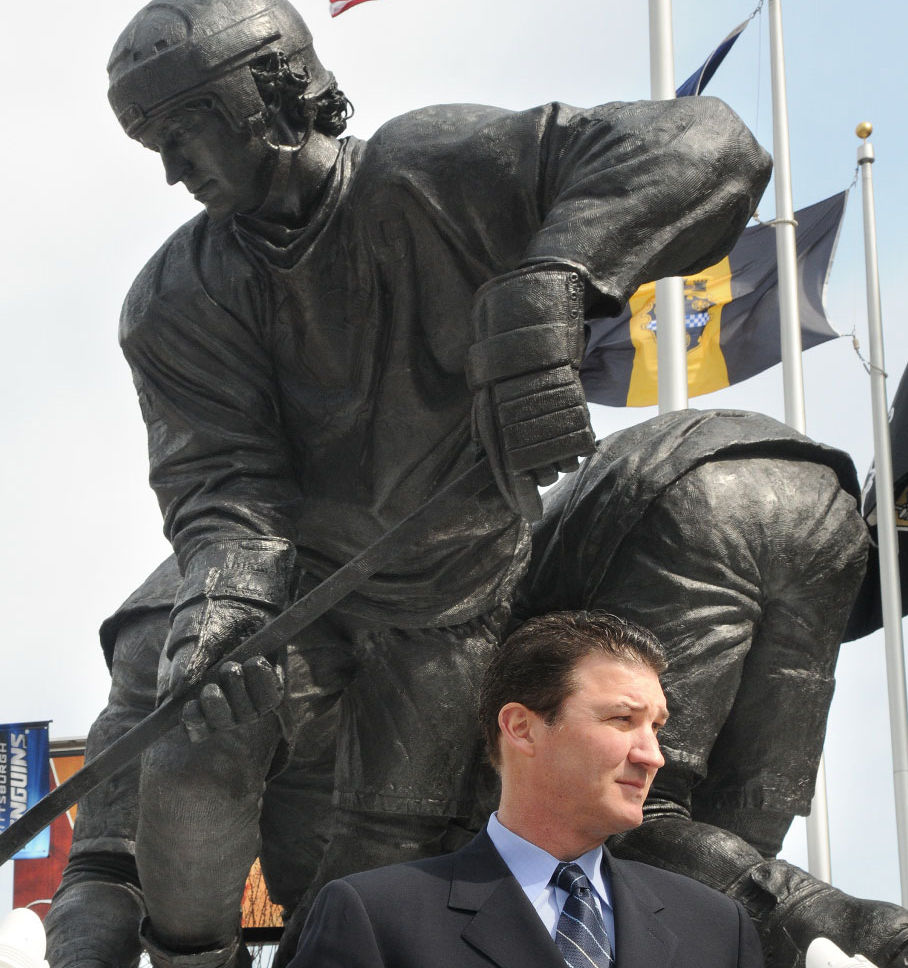
Bob Donaldson / Post-Gazette
Chapter 8 It’s For Them Read The Full Chapter
That statue, unveiled as “Le Magnifique” in March 2012, is a 4,700-pound rendering of Lemieux breaking through two defenders in a game from 1988.
Lemieux’s parents, wife and four children attended the ceremony on that sunny spring-like day, as past, present and future united. Pierrette and Jean-Guy Lemieux still live in the small house on Jogues Street in Montreal, and, while their four grandchildren have an appreciation for their French-Canadian heritage, they’re proud to have been molded in Pittsburgh.
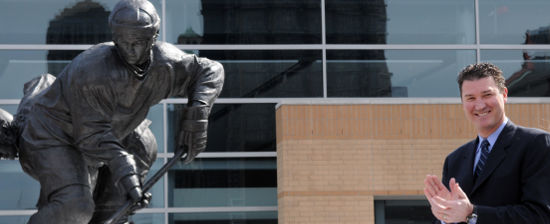
Lemieux at the unveiling of “Le Magnifique”.
Lauren Lemieux is in school at Babson College in Wellesley, Mass., but she interned this summer in Pittsburgh. Stephanie did her first year at Boston College but then transferred home to Carnegie Mellon. Austin and Alexa have one more year of high school before Mario and Nathalie will have an empty nest in Sewickley.
All generations of the Lemieux family will now be able to congregate at Mont Tremblant, the mansion Lemieux recently built in Quebec. But he does not want there to be any confusion. “This is my home, our home,” Lemieux says of Pittsburgh, “and we’re going to be here for a long time.”
Says friend Tom Grealish, “He’s a Pittsburgher at heart. Pittsburghers don’t like change a whole lot. We like predictability. We like going to the same golf course, the same restaurant. He’s a Pittsburgher in that he wants the same. He wants to be around the same people, go to the same places. He doesn’t want to be a jet-setter and go to parties and meet new people. He is content.”
At 30 years and going strong, it’s safe to say: the Lemieux-Pittsburgh partnership stands alone.
“It is unique,” says former Rangers goaltender John Vanbiesbrouck. “A lot of guys leave, go home, come back and wave every once in a while. There’s very few that have built a relationship with a fan base and a city like Pittsburgh and Mario. You look through all sports, I mean, who has that relationship?”
Credit Pittsburgh, too.
“This wouldn’t happen in New York,” team President David Morehouse says.
Lemieux understood at a young age that he wouldn’t be able to create the life he wanted in a big city like New York or a hockey-obsessed one like Montreal. Pittsburgh, thankfully, had just the right chemistry.